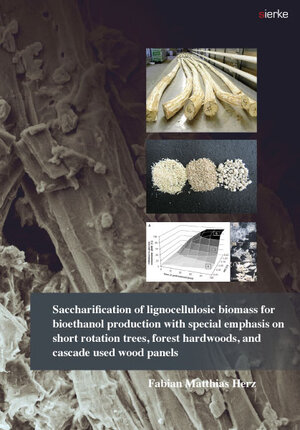
×
![Buchcover ISBN 9783868448078]()
Saccharification of lignocellulosic biomass for bioethanol production with special emphasis on short rotation trees, forest hardwoods, and cascade used wood panels
von Fabian Mattias HerzBioethanol, the most relevant liquid biofuel, has been produced by
fermentation of sugars derived from annual crops. Production from
non-food materials, like fast growing trees and forest wood waste
instead would be energetically more favourable with the further
advantage of not influencing food and feed production.
Today’s wood to bioethanol conversion is still struggling with respect
to energy and product efficiency. Developing and biochemically
optimizing a low energy consuming saccharification process chain
(SPC) for the production of bioethanol from lignocellulosic biomass
is the focus of this PhD thesis.
An acetosolv pretreatment process provided a basis to build upon.
This procedure can defibrillate the wood cell wall structure at moderate
temperatures and ambient pressure in a way that the cellulose is highly
preserved in the solids. Product efficient enzymatic hydrolysis makes
the developed SPC a promising technology. As a result, more than
75% of the original wood sources, being poplar, willow and beech,
were detected as potentially usable products from the investigated
process chain: Glucose for the production of bioethanol and furfural
and lignin as value-added co-products. Resources under investigation
were poplar and willow trees from short rotation forestry, beech and
spruce as German main forest tree species, wheat straw as an agricultural
residue and cascade used wood composite panels.
fermentation of sugars derived from annual crops. Production from
non-food materials, like fast growing trees and forest wood waste
instead would be energetically more favourable with the further
advantage of not influencing food and feed production.
Today’s wood to bioethanol conversion is still struggling with respect
to energy and product efficiency. Developing and biochemically
optimizing a low energy consuming saccharification process chain
(SPC) for the production of bioethanol from lignocellulosic biomass
is the focus of this PhD thesis.
An acetosolv pretreatment process provided a basis to build upon.
This procedure can defibrillate the wood cell wall structure at moderate
temperatures and ambient pressure in a way that the cellulose is highly
preserved in the solids. Product efficient enzymatic hydrolysis makes
the developed SPC a promising technology. As a result, more than
75% of the original wood sources, being poplar, willow and beech,
were detected as potentially usable products from the investigated
process chain: Glucose for the production of bioethanol and furfural
and lignin as value-added co-products. Resources under investigation
were poplar and willow trees from short rotation forestry, beech and
spruce as German main forest tree species, wheat straw as an agricultural
residue and cascade used wood composite panels.


